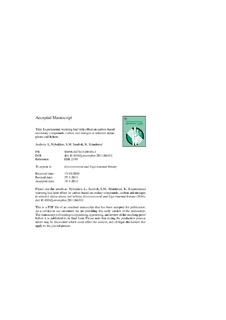| dc.contributor.author | Nybakken, Line | |
| dc.contributor.author | Sandvik, Sylvi M. | |
| dc.contributor.author | Klanderud, Kari | |
| dc.date.accessioned | 2011-09-22T12:54:58Z | |
| dc.date.available | 2011-09-22T12:54:58Z | |
| dc.date.issued | 2011 | |
| dc.identifier.citation | Nybakken, L., Sandvik, S. M., & Klanderud, K. (2011). Experimental warming had little effect on carbon-based secondary compounds, carbon and nitrogen in selected alpine plants and lichens. Environmental and Experimental Botany, 72(3), 368-376. doi: 10.1016/j.envexpbot.2011.04.011 | en_US |
| dc.identifier.issn | 0098-8472 | |
| dc.identifier.uri | http://hdl.handle.net/11250/138260 | |
| dc.description | Accepted version of an article published in the journal: Environmental and Experimental Botany. Published version available on Science Direct: http://dx.doi.org/10.1016/j.envexpbot.2011.04.011 | en_US |
| dc.description.abstract | Global warming is expected to change plant defence through its influence on plant primary resources. Increased temperature (T) will increase photosynthesis, and thus carbon (C) availability, but may also increase soil mineralization and availability of nitrogen (N). More access to C and N is expected to mainly increase plant growth, and, according to hypotheses on resource based defence, this could lower plant concentrations of carbon-based secondary compounds (CBSCs). We used two already established warming experiment with open top chambers (OTCs) and control plots in alpine south-western Norway, one on a ridge (8 years' treatment) and a one in a leeside (3 years' treatment), to study the effects of warming on plant and lichen defensive compound concentrations. The study included five vascular plant and six lichen species. One vascular plant species had lower concentration of CBSCs under elevated T, while the others did not respond to the treatment. In lichens there were no effects of warming on CBSCs, but a tendency to reduced total C concentrations. However, there were effects of warming on nitrogen, as the concentration decreased inside OTCs for three species, while it increased for one lichen species. Lichens generally had higher CBSC and total C concentrations on the ridge than in the leeside, but no such pattern were seen for vascular plants. No elevated temperature effect on CBCSs is most probably a result of high constitutive defence under the limiting alpine conditions, suggesting that chemical defence is little subject to change under climate warming, at least on a short-term basis. We suggest that the driving forces of plant defence in the arctic-alpine should be tested individually under controlled conditions, and suggest that competition from other plants may be a greater threat under climate warming than increased herbivory or disease attacks. | en_US |
| dc.language.iso | eng | en_US |
| dc.publisher | Elsevier | en_US |
| dc.title | Experimental warming had little effect on carbon-based secondary compounds, carbon and nitrogen in selected alpine plants and lichens | en_US |
| dc.type | Journal article | en_US |
| dc.type | Peer reviewed | en_US |
| dc.subject.nsi | VDP::Mathematics and natural science: 400::Zoology and botany: 480::Ecology: 488 | en_US |
| dc.subject.nsi | VDP::Mathematics and natural science: 400::Zoology and botany: 480::Plant physiology: 492 | en_US |
| dc.source.pagenumber | 368-376 | en_US |
| dc.source.volume | 72 | en_US |
| dc.source.journal | Environmental and Experimental Botany | en_US |
| dc.source.issue | 3 | en_US |
